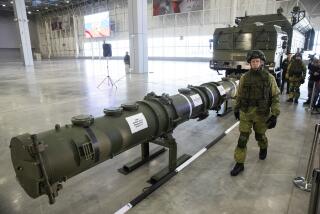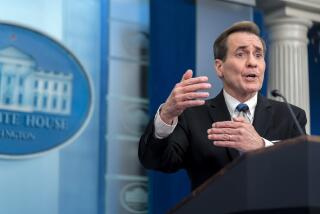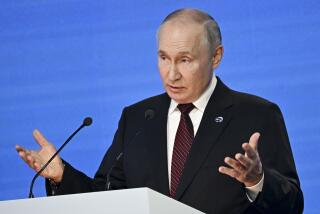THE SUMMIT AT GENEVA : Laser Tests Held in Space, Soviets Admit for 1st Time
GENEVA â A senior Soviet Defense Ministry official acknowledged for the first time here Sunday that the Soviet Union conducts laser âexperiments and testsâ against orbiting satellites, but he insisted that similar research by the United States as part of its space defense program would violate the ABM treaty.
The Pentagon on several occasions has accused Moscow of conducting an extensive missile defense program, with even larger budgets than the current effort by the Reagan Administration. But the Soviets had not admitted publicly until now that they are doing experiments reaching into space, as several U.S. Defense Department publications have charged, from two or more huge laser test facilities pointed skyward at Sary Shagan, in Central Asia.
Asked about the U.S. charges, Dr. Yevgeny P. Velikov of the Soviet Academy of Sciences responded carefully that the Soviet Union âdoes not develop, test or deploy space arms,â leaving the implication that it does conduct research on space defense weapons.
Col. Gen. Nikolai Tchervov, a three-star general who often acts as spokesman for the Soviet Defense Ministry, chimed in that Moscow has lasers that are not space weapons âbut are used for experiments and tests, to locate and detect (satellites) orbiting in our direction.â
These lasers do not violate the 1972 Anti-Ballistic Missile Treaty, he declared, adding that lasers and other beam weapons intended for use as space strike weapons âmust be banned at every stage (of development), including at the level of scientific research.â
Differences Over Purpose
The distinction the Soviet official sought to draw appeared to hinge primarily on differences in the stated purposes of building such lasers rather than on basic technical differences.
And it underscored the continuing difficulties both Moscow and Washington are having in spelling out just what kinds of research on potential space weapons are permitted under the ABM treaty--an issue that has emerged as the central roadblock to a new arms agreement.
The Soviet research was not intended to develop space weapons, Tchervov said, but such U.S. lasers--if developed as part of the Reagan Administrationâs Strategic Defense Initiative space defense program--would violate the treaty, he said.
Yet the laser facilities he acknowledged that Moscow has developed are of a type that could be upgraded relatively easily to achieve space weapons capability.
Another top Soviet scientist indicated that if the United States wanted to undertake a laser effort comparable to the Soviet program, President Reagan should negotiate the matter with Soviet leader Mikhail S. Gorbachev in the summit, which formally opens here Tuesday.
Dr. Raold Sagdeev, director of the Soviet Institute of Space Research, said the Soviet research was âvery differentâ from U.S. laser research since its laser beams illuminated satellites only weakly while U.S. laser tests are designed to destroy missiles at great distances.
Asked during a brief interview if U.S. laser tests similar to the Soviet experiments would be permitted under the ABM treaty, Sagdeev said, âThatâs negotiable.â
Soviet Inconsistencies
Commenting on the inconsistencies of the Soviet statements in response to a question at a later briefing, Reaganâs national security adviser, Robert C. McFarlane, said, âThey are going to have to duke it out and figure out which is their position.
âThe United States bases its position upon the authoritiesâ (language) of the ABM treaty, on the realities of the very substantial Soviet (space defense) program, and our view of what helps create stability,â he added. âAnd we are very, very open to a discussion with the Russians about that.â
U.S. officials, however, are themselves far from united on the same matter, as the publicly embarrassing leak of a letter from Defense Secretary Caspar W. Weinberger dramatized over the weekend.
And while they may be signaling a willingness to accept applied research as permissible under the treaty, the Soviets have previously dropped hints of similar willingness to negotiate, only to back off later.
In September, Gorbachev suggested fundamental research would be legal, but in Moscow two weeks ago the Soviets returned to their former demand that all aspects of space weapon work be banned, including basic research.
Both sides, in fact, appear to have a difficult time in getting every member of the team to speak with the same voice, whether because of political disagreements or bureaucratic confusion. The exposure of these internal problems in the full glare of international publicity may add to the difficulty of making prudent compromises on this knottiest summit problem.
More to Read
Sign up for Essential California
The most important California stories and recommendations in your inbox every morning.
You may occasionally receive promotional content from the Los Angeles Times.










